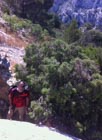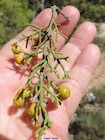Conservation Status

Juniperus phoenicea
Linnaeus 1753, p. 1040
Common names
Phoenician juniper (a very bad name, since it occurs nowhere near the limits of ancient Phoenicea); savina [Catalan], Genévrier de Phénicie [French]; ginepro fenicio [Italian]; Sabina Mora [Spanish]. Note that these names are typically also applied to Juniperus turbinata.
Taxonomic notes
Formerly two subspecies were recognized, but one is now generally recognized as J. turbinata; since that taxon has a distinctive distribution and ecology, this has prompted a re-evaluation of J. phoenicea, and much of the published literature up to about 2015 should be taken in reference to J. turbinata. The most detailed molecular studies done to date (summarized in Juniperus) show the two species to be, along with Juniperus canariensis, sisters in a highly distinctive clade within Section Sabina. This clade is not closely related to any other junipers. Mazur et al. (2016) estimate that the species diverged within the last two million years, while Mao et al. (2010) estimate the phoenicia-turbinata clade to be more than 30 million years old.
There are two named hybrids, both reported from the province
of Castellon in Spain. Juniperus × palanciana J.M.Aparicio & Uribe-Ech. is the hybrid of J. phoenicea and J. thurifera, and Juniperus × herragudensis J.M.Aparicio & Uribe-Ech. is the hybrid of J. phoenicea and J. sabina (Boratyński et al. 2024, Rojo and Uribe-Echebarría 2008).
There are 15 synonyms, given at POWO. However, the main concern with nomenclature is that many authors continue to use "J. phoenicea" to describe J. canariensis and/or J. turbinata. Fortunately the three species have largely distinct ranges, except that J. phoenicea and J. turbinata both occur in the northwest Mediterranean area, albeit in largely distinct habitats.
These three species, commonly called the J. phoenicea complex, are a good example of something we've seen a lot of since molecular taxonomy became popular: species that seldom or never hybridize, but that have almost identical morphology. There are minor morphology differences if you know what to look for, but they are subtle, certainly not of the prominence that is commonly used to draw a line between different species. However, they occupy distinct ecological niches, and they have a means of reproductive isolation: flowering at different times of the year.
Description
To better highlight the differences, the following description applies to all three species in the J. phoenicea complex:
Monoecious or (10-50% of plants) functionally dioecious evergreen shrubs, or trees to 12 m tall; crown conical, with age becoming rounded and irregular, especially on windy sites, where stems may be prostrate. Bark on older trees brown, exfoliating in strips. Twigs 1 mm diameter, round, scaly, at first upright but with age bent or pendent; on old trees arrayed in tufts at branch ends; foliage decussate or in alternating whorls of 3; leaves die after 3-4 years but remain in situ on the twig for 1-2 years longer. Leaves both whip and scale-like. Whip leaves on juvenile plants, 5-14 × 0.5-1 mm, acute, mucronate, with two stomatal bands on both adaxial and abaxial surfaces. Scale leaves on adult plants 0.7-1 mm long, ovate-rhombic, closely appressed, amphistomatic, obtuse to somewhat acute, with an ovate to elongate abaxial gland having a single resin cavity. The leaf surface is smooth, light green, and somewhat lustrous or greyish; the leaf margins are entire or very slightly denticulate. Leaves on the vigorously growing, upright shoots are prickly and approximately two times longer than on the lateral twigs of the previous year. Pollen cones start to develop in late summer, shortly before seed cones. They are terminal on short shoots, ellipsoidal, to 4 mm long and 2 mm wide, yellowish-green or whitish-green, turning yellowish when mature. They are composed of 6–16 decussate or (less frequently) ternate microsporophylls, which are shield-shaped with serrate margins, and which each produce 3 to 5 microsporangia. After pollen release, the cones turn brown and persist on the trees until summer. Seed cone structure is much more variable than is usual in Juniperus species. The number of scale whorls, the number of ovules per seed scale, the decussate or ternate arrangement of scales, and the presence or absence of a distal ovule are all highly variable. Macrostrobili (receptive female cones) are greenish or pinkish, 1.5 × 2 mm, composed of 4–9 bracts with 1–2–(3) ovules each. Mature seed cones 5-15 mm diameter, ripening in the 2nd year, globose to ovoid, first soft and juicy, later drying and becoming fibrous, changing from blackish to green or yellowish, sometimes slightly pruinose; dark red at maturity. Seeds usually 3-9(-13) per cone, small, triangular, flattened. Cotyledons 2. Wood does not contain resin canals; heartwood is reddish brown and resinous. 2n=22 (Farjon 2010, Adams 2014, Boratyński et al. 2024). See Boratyński et al. (2024) and García Esteban et al. (2004) for a detailed characterization of the wood anatomy.
The following description emphasizes characters that differ between J. phoenicea, J. canariensis, and J. turbinata:
Shrub, or a small tree 3-4(-8) m tall, with a short trunk having an irregular cross-section. Old plants often have only a strip of living bark on the trunk. Current-year twigs have an average diameter of 0.84 mm. The 1-year-old twigs on mature plants are straight or slightly bent, with an obtuse apex and gray to brownish bark. Leaves ca. 2 mm long, which is longer than on the other two species; apex obtuse to subacute. Pollen shed in February-March. Seed cones 5–11 × 5.5–12 mm, slightly oblate (elongate in the other species), brown, red or copper-red. Seeds 2–16, each 2.5-5.5 mm long (cones and seeds somewhat smaller than in the other species) (Boratyński et al. 2024).
Distribution and Ecology
Andorra, France, Italy: west Liguria and in Tuscany on the Apuane Alps, and Spain. Generally occurs in the western Mediterranean region, with most localities in the Iberian Peninsula and southern France, with a restricted area of distribution in northwestern Italy. Grows at elevations of 0-1200(-1970) m in mountainous areas, in areas with average annual precipitation of more than 600 mm, on carbonate-derived soils. The highest-elevation occurrences are in the Sierra Mágina of Spain (Adams 2014, Mazur et al. 2016, Boratyński et al. 2024). Zone 9 (cold hardiness limit between -6.6°C and -1.1°C) (Bannister and Neuner 2001).
J. phoenicea in Spain and France is parasitized by the mistletoe Arceuthobium gambyi Fridl. (Fridlender 2015).
The "Least Concern" conservation status reflects a large area of occupancy, within which this tree is often common; there is little evidence of ongoing decline, and it is present in many protected areas (Allen 2017). However, a climate change study suggests considerably more dire outcomes if forecasts for the late 21st Century come to pass, with a likely conservation status of "Vulnerable" or "Endangered" (El-Barougy et al. 2023).
Remarkable Specimens
The oldest specimens have been found growing on cliffs in the Gorges de l'Ardèche in France; these have been aged, using dendrochronological methods, at up to 1,450 years (Mandin 2005). Analysis by Mathaux et al. (2016) suggests that some of these trees are even older; they used wiggle-match radiocarbon dating to establish that these trees, although crossdatable, nonetheless contain some missing rings (Mathaux et al. also provide excellent photos of trees on cliffs and finished cross-sections). Elsewhere, the oldest individuals are also found growing on cliffs; in Spain the oldest tree was estimated, using radiocarbon dating, at 927 years (Camarero and Ortega-Martínez 2019).
Ethnobotany
I have found no detailed references to use of this species, but it is occasionally mentioned as a source of timber or firewood. Junipers in general are commonly used to flavor meat dishes and, due to their high essential oil content, for varied medicinal purposes.
There has been some successful dendrochronological work with this species (Mandin 2005), and some unsuccessful work (Camarero and Ortega-Martínez 2019). The latter study found over 30% missing rings in some Spanish specimens. Many trees have a strip-bark growth habit, and cross-sections of such stems often show wedging rings (Boratyński et al. 2024).
Observations
I haven't identified any specific locations, but there are over a thousand observations of J. phoenicea posted on iNaturalist, covering most of the species' range. Most of the posted locations will be accessible to members of the general public.
Remarks
The epithet is a misnomer; it refers to the ancient seafaring nation of Phoenicea and is a good metaphor for the distribution of J. turbinata, found on shorelines all around the Mediterranean. The type specimen, however, is from the northwest Mediterranean, over 2,500 km from Phoenicea.
Citations
Adams, R. P. 2014. Junipers of the World, 4th ed. Trafford, Bloomington, IN. 415 p.
Allen, D.J. 2017. Juniperus phoenicea. The IUCN Red List of Threatened Species 2017: e.T16348983A99965052. https://dx.doi.org/10.2305/IUCN.UK.2017-2.RLTS.T16348983A99965052.en. Downloaded on 19 May 2020.
Boratyński, Adam , Montserrat Salvà-Catarineu, Katarzyna Marcysiak, Małgorzata Mazur, Ángel Romo, Pietro Minissale, Kit Tan, Grzegorz Iszkuło, Radosław Witkowski, and Andrzej Mazur. 2024. Biology and ecology of the Juniperus phoenicea – J. turbinata – J. canariensis complex I. Taxonomy, structure and distribution. Dendrobiology 92:1–31. https://doi.org/10.12657/denbio.092.001.
Camarero, J. Julio, and Miguel Ortega-Martínez. 2019. Sancho, the oldest known Iberian shrub. Dendrochronologia 53:32–36. https://doi.org/10.1016/j.dendro.2018.11.003.
El-Barougy, Reham F., Mohammed A. Dakhil, Marwa Waseem A. Halmy, Marc Cadotte, Susana Dias, Emad A. Farahat, Ali El-Keblawy, and Louis-Félix Bersier. 2023. Potential extinction risk of Juniperus phoenicea under global climate change: towards conservation planning. Global Ecology and Conservation 46: e02541. https://doi.org/10.1016/j.gecco.2023.e02541. Note that the authors did not discriminate between J. phoenicea and J. turbinata.
Farjon, Aljos. 2010. A Handbook of the World's Conifers. Leiden, Netherlands: Brill Academic Publishers.
Fridlender, Alain. 2015. Taxons nouveaux dans le genre Arceuthobium M. Bieb. (Viscaceae, Santalales).
Bull. Mens. Soc. Linn. Lyon 84:269-292. Available https://www.persee.fr/doc/linly_0366-1326_2015_num_84_9_17840, accessed 2025.01.02.
Linnaeus, C. 1753. Species Plantarum 2: 1040.
Mandin, Jean-Paul. 2005. Découverte de très vieux genévriers de Phénicie (Juniperus phoenicea L.) dans les
gorges de l’Ardèche (France). Le Journal de Botanique 29: 53–62. Available https://www.persee.fr/doc/jobot_1280-8202_2005_num_29_1_1991, accessed 2025.01.02.
Mao, K., G. Hao, J. Liu, R. P. Adams, and R. I. Milne. 2010. Diversification and biogeography of Juniperus (Cupressaceae): variable diversification rates and multiple intercontinental dispersals. New Phytologist 188(1):254–272.
Mathaux, C., Mandin, J.-P., Oberlin, C., Edouard, J.-L., Gauquelin, T., and Guibal, F. 2016. Ancient juniper trees growing on cliffs: Toward a long Mediterranean tree-ring chronology. Dendrochronologia 37:79–88. https://doi.org/10.1016/j.dendro.2015.12.005.
Mazur, M., K. Boratynska, K. Marcysiak, D. Gomez, D. Tomaszewski, J. Didukh and A. Boratynski.
2003. Morphological variability of Juniperus phoenicea (Cupressaceae) from three distant localities
on the Iberian peninsula. Act. Soc. Bot. Poloniae 72:71-78.
Rojo, J., and P. Uribe-Echebarría. 2008. Juniperus herragudensis, otro nuevo
híbrido de la provincia de Castellón. Mainhardt 60:83–85.
See also
Arista, M., P. L. Ortiz, and S. Talavera. 1997. Reproductive isolation of two sympatric subspecies of Juniperus phoenicea (Cupressaceae) in southern Spain. Plant Systematics and Evolution 208:225–237.
Elwes and Henry 1906-1913 at the Biodiversity Heritage Library. This series of volumes, privately printed, provides some of the most engaging descriptions of conifers ever published. Although they only treat species cultivated in the U.K. and Ireland, and the taxonomy is a bit dated, still these accounts are thorough, treating such topics as species description, range, varieties, exceptionally old or tall specimens, remarkable trees, and cultivation. Despite being over a century old, they are generally accurate, and are illustrated with some remarkable photographs and lithographs.






